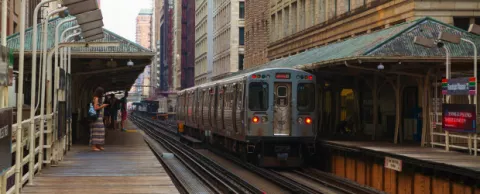
Is transit ridership fated to follow the ups and downs of gas prices?
Michael Melaniphy believes the latest annual report from the American Public Transportation Association (APTA) shows otherwise.
“Despite the steep decline in gas prices at the end of last year, public transit ridership increased,” says Melaniphy, the CEO of APTA. “This shows that once people start riding public transit, they discover that there are additional benefits besides saving money.”
The new report from APTA says that Americans took 10.8 billion trips on public transportation in 2014 -- the highest annual ridership number in 58 years. Rail leads the way in ridership increases, with both heavy rail -- subways and elevated trains --and commuter light rail posting gains over 3%. Bus ridership nationwide fell by 1%, according to the report.
More options equal more riders
Several factors appear to influence rising ridership rates, including more transit options.
“In the past people had a binary choice,” said Melaniphy in a press release. “You either took public transit, most likely a bus, or you drove a car. Now there are multiple options with subways, light rail, streetcars, commuter trains, buses, ferries, cars and shared use vehicles.”
Ridership numbers may also be getting a bump from the economic recovery and higher employment. The APTA estimates that 60% of public transportation trips are for work commutes.
Greater availability of transit services may be playing a role, too. A number of cities have recently completed large transit projects -- or portions of them. In the Denver metro area, for example, the FasTracks transit expansion program continues to open new rail lines and stations, pushing up light rail use up 12%. Light rail in Minneapolis saw a ridership surge of more than 57% due to the opening of the METRO Green Line.
Cities with largest ridership gains
The ATAP report captures 2014 ridership numbers for a number of cities categorized by transit mode.
- Commuter light rail ridership. The ATAP reports a nationwide increase of 2.9 percent in 2014, with 22 out of 28 public transit systems attesting to ridership upticks. Double-digit increases were registered in Salt Lake City (16.2%); Stockton, CA (15.7%); Seattle -Sound Transit (10.4%); and San Carlos, CA (10.1%).
- Heavy rail ridership. Ridership on subways and elevated trains jumped by 3.3 percent across the country as 8 out of 15 public transit systems reported increases. Leading the way were transit operations in the cities of San Francisco (6.1%); Boston (4.9%); Chicago (4.1%); New York --NY-MTA NYC Transit (4.0%) and NY-MTA Staten Island Railway (3.5%); Atlanta (2.3%); and Miami (2.1%).
- Bus ridership. While decreasing slightly, ridership in small and medium size populations saw overall increases. Cities seeing bus riding bumps in 2014 included Baltimore (6.8%); Portland, OR (5.3%); Oakland (4.2%); San Francisco (3.9%); Columbus, OH (3.0%); Atlanta (2.8%); San Diego (2.4%); and Seattle-King County DOT (2.0%).
You can download the complete ATAP report here to see if your city’s ridership numbers are provided.
Related articles …
Study: Free parking benefits reduce public transit ridership
How to sweet talk car drivers into using the bus
Lessons from London: Making your transit system (almost) pay for itself



